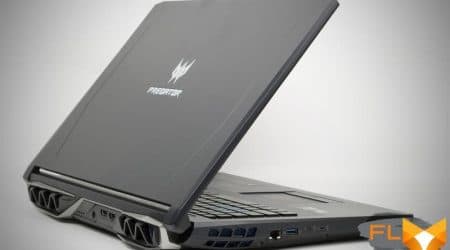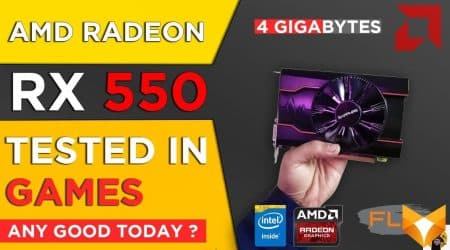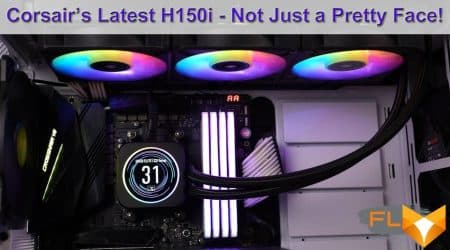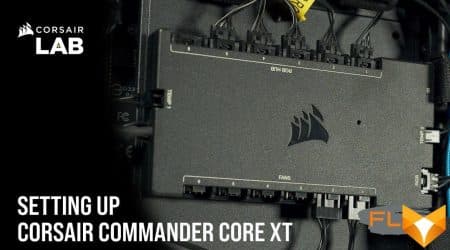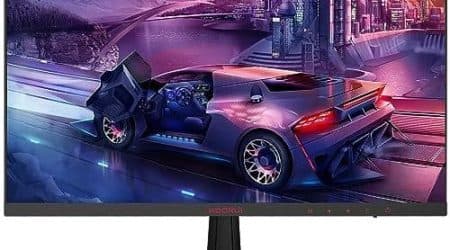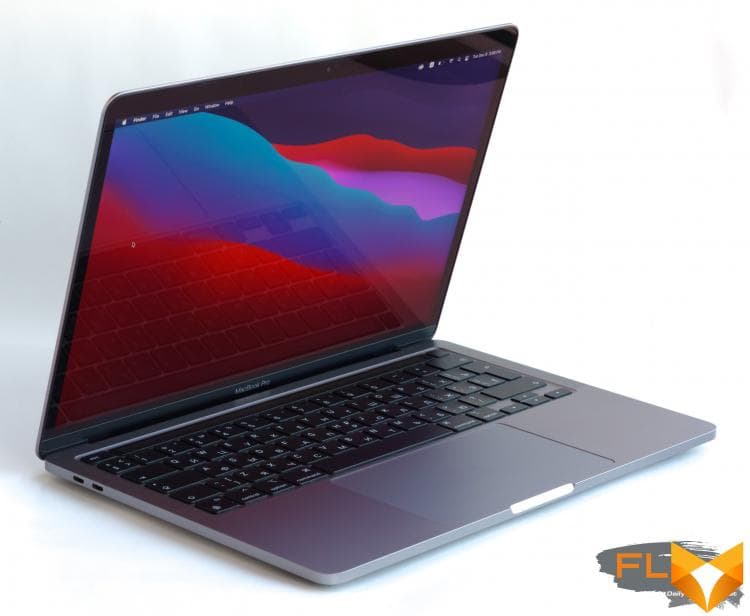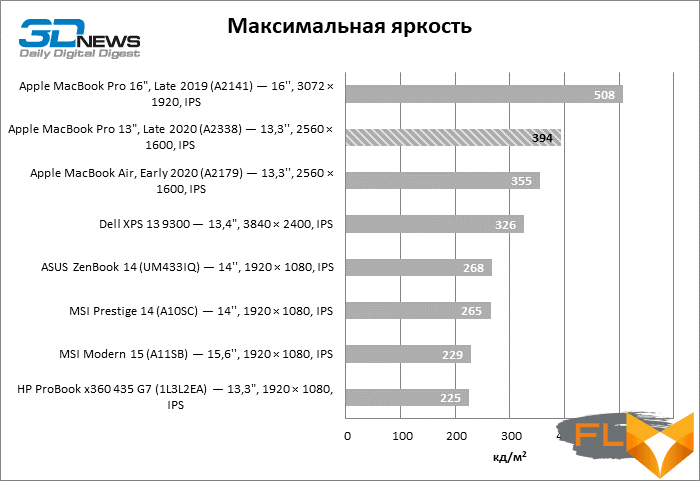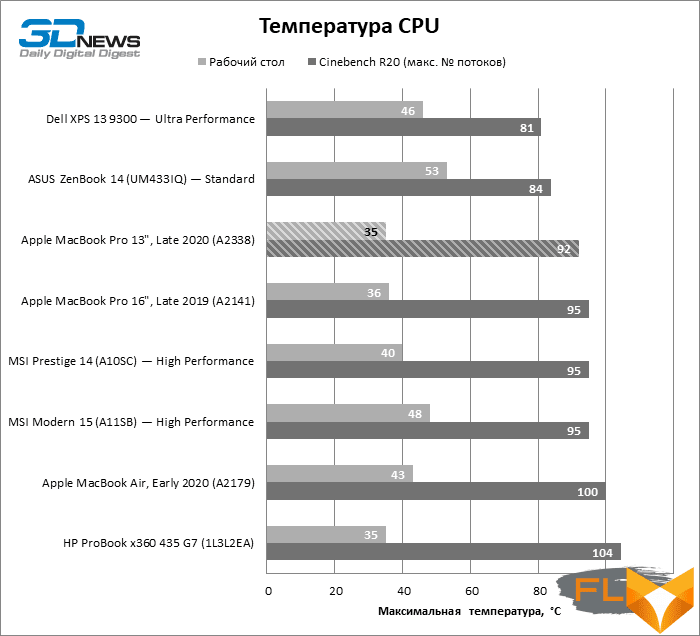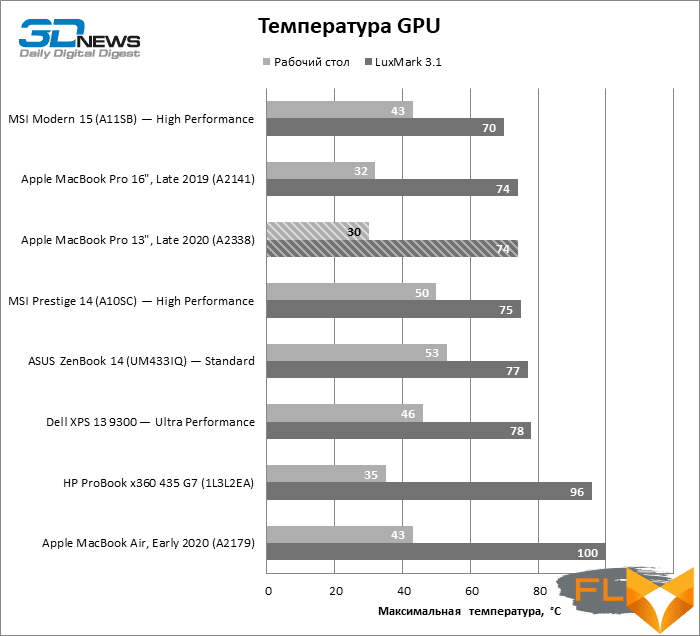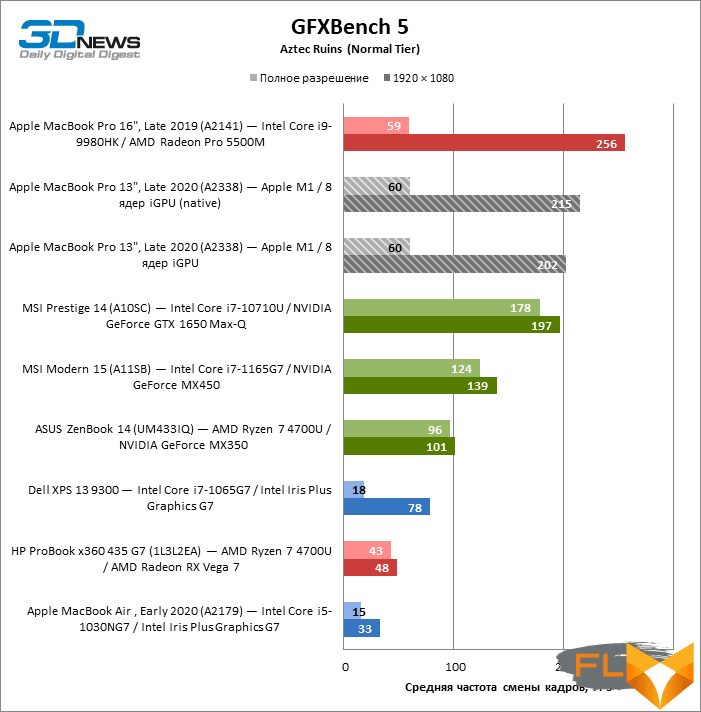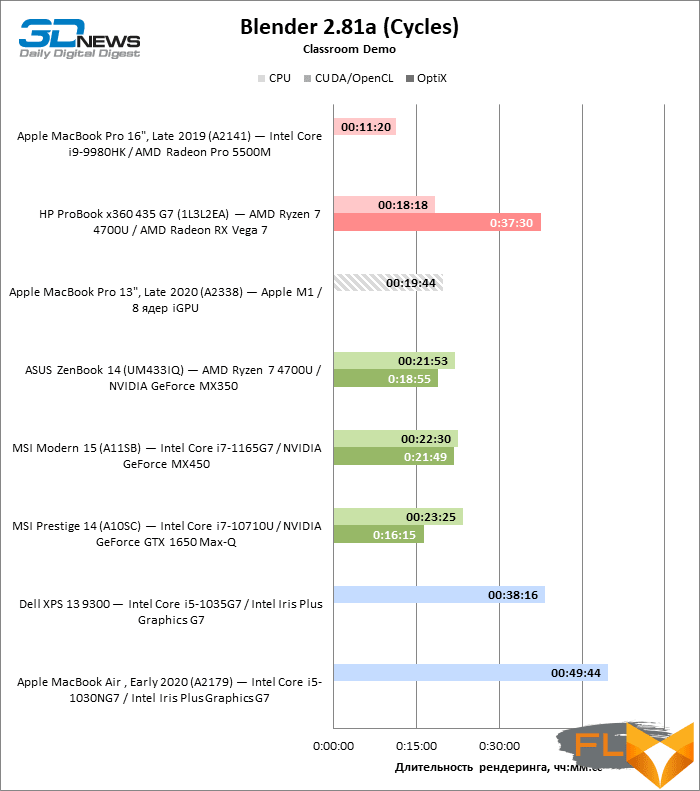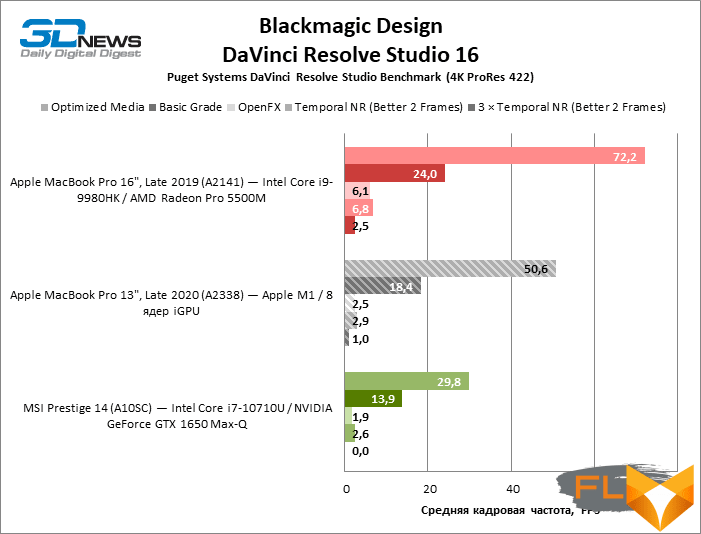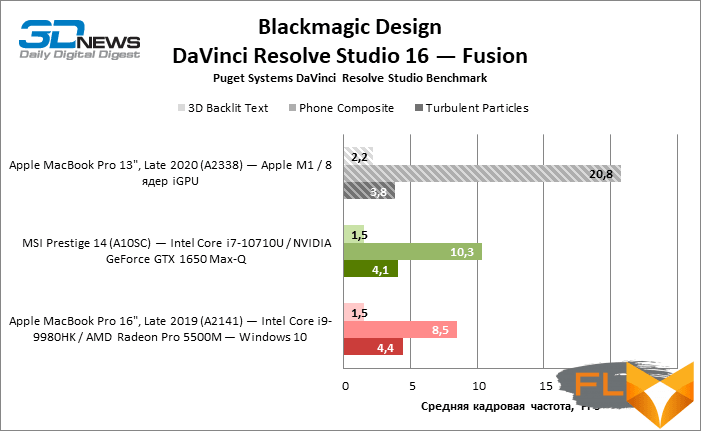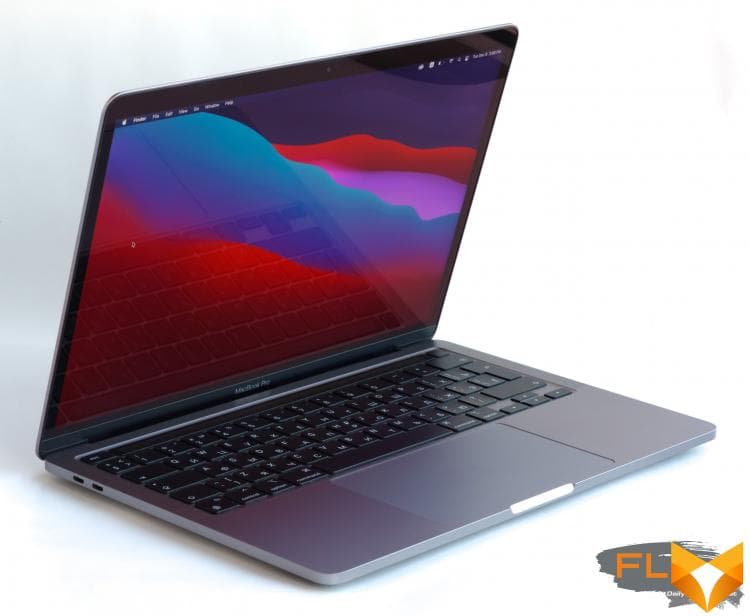


Talk that Apple will abandon Intel processors in favor of solutions of its own design has been going on for a long time. Earlier this year, the Cupertino-based company distributed test systems with the A14 mobile chip to selected partners to prepare macOS software developers for the migration to the new architecture, and now it has finally taken a life-changing step. The Apple M1 system-on-a-chip that powers the new generation Mac Mini, MacBook Air, and 13-inch MacBook Pro is set to change everything—dramatically improve performance, extend battery life, and bring a host of features that add up to the overall user experience. experience running the new version of macOS, because now Apple controls the hardware and software of its products inside and out.
Moreover, according to the manufacturer’s promises, M1 not only corrects the shortcomings of previous Maubuks, which are burdened by the voracious and hot Intel silicon, but is simply the most productive chip among notebook CPUs. Let’s take a look at what Apple has done to support such high-profile claims, and how true they are.
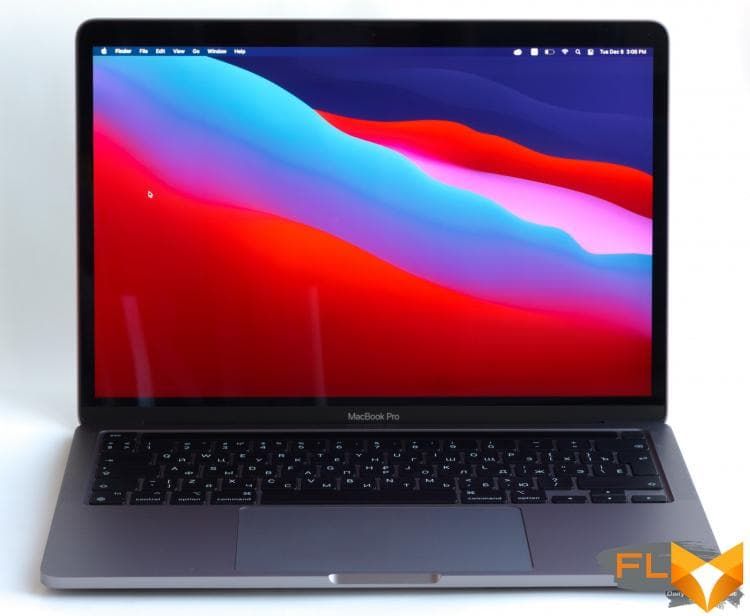
⇡#Goodbye x86. Hello ARM
The Apple M1 crystal replaced both Intel processors and several auxiliary discrete components on the motherboard, such as an SSD controller and a T2 security chip. Unlike the Intel and AMD products that dominate ultrabooks today, the M1 CPU section runs the ARM instruction set, or more specifically, the latest iteration of ISA called ARMv8.6-A with 64-bit AArch64 extensions. The M1 CPU consists of two blocks of cores – four high-performance Firestorm cores and four energy-efficient Icestorm cores. The operating system distributes the workload between each type of core according to the nature of the task, but note that when the computer needs to give its all to the maximum (for example, in rendering 3D graphics or video encoding), all eight cores work equally, so M1 it can be considered as an eight-core CPU, but adjusted for the limited capabilities of an energy-efficient cluster.
The Firestorm and Icestorm cores share the M1 with the A14 Bionic chip used in the latest generation of iPhones, but Apple has beefed up the design to meet the higher demands of the desktop environment. In particular, the high-speed Firestorm cores got an impressive amount of cache: L1 of each core holds 192 KB of data and 128 KB of instructions, and the total L2 is 12 MB. For small Icestorm cores, these figures are 128 KB, 64 KB and 4 MB, respectively.
The fundamental differences between Apple’s proprietary systems-on-a-chip and x86-compatible CPUs do not come down to a different set of instructions and asymmetric core clusters. Firestorm cores feature the widest pipeline of any commercially available processor and can decode eight instructions per clock. For comparison: current Intel and AMD solutions are limited to four instructions due to the peculiarities of the x86 instruction set (uneven instruction length). Further down the Firestorm pipeline, a high processing rate is supported by a mass of execution units running in parallel.
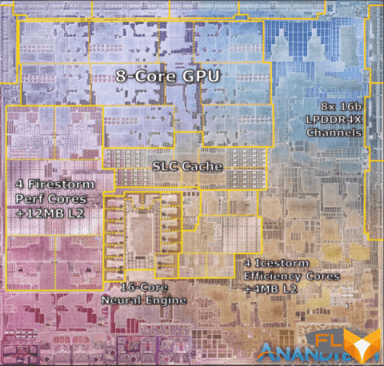
Abstract Anandtech
As a consequence of the wide architecture, the M1 CPU-on-chip promises a significant IPC (instructions per clock) gain over x86 hardware and thus advanced single-threaded performance without the need for the high clock speeds that Intel and AMD chips strive for. Apple, as usual, does not declare such parameters as the power consumption of the crystal. But according to our own measurements (which confirm data from other credible sources), the frequency of the Firestorm cores in an actively cooled device (MacBook Pro or related Mac Mini) does not exceed 3.2 GHz, and the Icestorm ceiling is about 2 GHz.
The TDP of the M1 chip on the MacBook Pro platform is 20-21W, which is in line with typical power benchmarks for midrange notebook chips. But in terms of the component budget, this is a real giant: the crystal contains 16 billion transistors. For comparison, AMD’s eight-core Renoir chip is only 9.8 billion. Thanks to the advanced 5 nm process technology that Apple used at the Taiwanese TSMC facilities.
An impressive share of the M1 area is occupied by an integrated graphics processor. The GPU consists of eight cores, each of which combines 128 shader ALUs. The M1-based MacBook Air deactivated one core, but the MacBook Pro and Mac Mini got a chip with a fully functional graphics pipeline. In total, the GPU contains 1024 shader ALUs, 64 texture mapping units, and 32 rasterization operations units (ROPs). Comparing this configuration with the video adapters built into Intel and AMD CPUs is simply pointless. Suffice it to say that according to the ALU, TMU and ROP formula, it completely coincides with the mobile version of the GeForce GTX 1650 from NVIDIA. Of course, this does not mean that the devices are equal in terms of performance in real conditions. In particular, the CPU and GPU in the M1 share a common RAM bus, while the GTX 1650 has its own GDDR5 or GDDR6 array. Nevertheless, the M1 integrated graphics is not only the most powerful solution in its class today, but also a direct replacement for entry-level discrete GPUs.
Finally, another important component of the M1 is the 16 cores of the so-called Neural Engine, which serve to speed up machine learning tasks. With macOS 11 (Big Sur), Apple released the ML Compute framework and TensorFlow platform files, compiled and optimized for its own architecture, so that the M1 can also take over the machine learning features that NVIDIA silicon is famous for.

iFixit Photo
But of course, all the promises of M1 record performance in the mobile SoC class will come true only if the application code, firstly, is compiled for ARM’s ISA, and secondly, contains specific optimizations for the M1 architecture. Therefore, Apple timed the release of the new Macs with a full-scale update of the operating system, which was awarded the next non-number in the name – macOS 11 – a full 19 years after the debut of Mac OS 10.0. All OS binaries and Apple branded applications are adapted to work on the M1 processor. Most of the programs that come preinstalled on a laptop with macOS do not take more than one second to launch, and the laptop itself wakes up almost instantly when you lift the screen lid. In general, the benefits of switching from x86 to ARM are felt immediately.
What about third party products? The list of known applications that have already been ported to native code for M1 or will be ported in the future includes (but is not limited to) the Google Chrome browser, Adobe professional visualization tools, DaVinci Resolve video editor and Microsoft Office.
At the same time, any (at least in theory) program from an extensive library created for previous versions of macOS and x86 architecture works on M1 through the Rosetta 2 emulator. The computer prompts you to install it when you first start incompatible software and then does not require any additional actions. Old and new apps run the same way, and we haven’t encountered Rosetta 2 causing any crashes or noticeable slowdowns to the naked eye. And we still have time to measure the real overhead from emulation in benchmarks.
However, the migration of Apple computers to a new architecture does not mean that devices of the past generation will immediately lose access to updated software. The upgrade to macOS 11 is far from open to the latest Mac models, and third-party programs compatible with the M1 are distributed as universal binaries. By the way, this format allows you to pass any application through Rosetta 2 if suddenly the native code causes any problems or you want, as in our case, to compare the performance of versions compiled for different architectures. It is enough to check the properties of the package with the program, and the executable file itself can be run in the terminal using the command:
arch -x86_64
Finally, apps from the App Store for iPhone and iPad can now be opened on macOS if there is no desktop alternative. But what buyers of the new Macs have irretrievably lost is the ability to install Windows on bare metal through Boot Camp, and virtual machines so far can only cope with the useless ARM assembly of Microsoft OS for most users. Parallels promises to soon solve the complexities of x86 Windows virtualization, which in this case will have to be combined with instruction emulation, and we can’t wait to see how much this will hit performance. But, whatever one may say, the Mac is now once again undocked from the world of personal computers in the strict sense of these words.
⇡#Other specifications, prices
The RAM of the MacBook Pro is soldered on the same substrate with the M1 chip in the form of two high-density chips with a total capacity of 8 or 16 GB. The LPDDR4X chips are rated for a single channel bandwidth of 4266 MT/s, which is the standard for a lot of the latest generation ultrabooks based on Intel Ice Lake or Ryzen 4000 chips. But the M1 has one important difference: while two LPDDR4X channels on a typical x86 platform form a 64-bit wide data transfer interface, Apple uses a wide 128-bit bus. As a result, the RAM bandwidth is actually doubled here, which is especially important for the integrated GPU. M1 uses a unified system memory architecture, where the CPU and GPU cores have equal access to external memory.
The only problem with the M1’s integrated design is that 16 GB of RAM is currently the minimum for demanding professional applications, and it no longer looks redundant for everyday work. Future-proof RAM for the new MacBook Pro is in question, and configurations with 8 GB of RAM are best forgotten right away: if you are not going to run work applications that require more RAM or keep dozens of pages open in the browser, you should consider the latest MacBook Air cheaper generations.
Here is the complete order with the volume of the drive. The base configuration includes a 256 GB SSD, and this again will be enough only for the most casual users, but it is possible to upgrade up to 2 TB. Only this, as well as RAM, needs to be taken care of at the stage of purchase. No component of the laptop can be replaced by yourself.
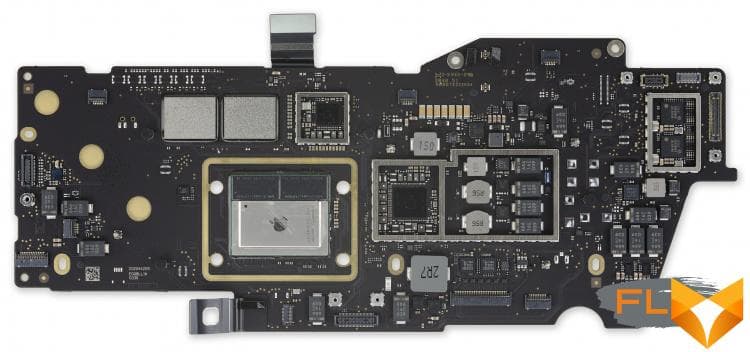
iFixit Photo
Together with the M1 chip, Apple laptops have gained support for the WiFi 6 (IEEE 802.11ax) network standard. However, the MacBook Pro’s wireless module is not designed for the full throughput of the specifications. In fact, it has also dropped from the estimated 1.3 Gb / s of the previous models of the 13-inch MacBook Pro to 1.2 Gb / s. However, the WiFi 6 standard is not only and not so much about data transfer speed, but about stability in busy networks and energy savings, which is one of the main priorities for Apple engineers.
On the wired side, the MacBook Pro boasts Thunderbolt 3, which – also a first for a Mac – is capable of operating in USB 4 Alt Mode. As you can see, Intel has been weaned off future Apple products, but Thunderbolt support hasn’t gone with it. The M1 does not need a discrete controller from Intel, and all the necessary logic is built right into the SoC. However, the passport data does not say anything about USB speed. According to the standard, it should not be less than 20 Gb / s, which is the equivalent of USB 3.2 Gen 2 × 2, but it goes up to 40 Gb / s (like Thunderbolt 3). In any case, this is an extremely fast interface for users of modern peripherals that can saturate its bandwidth. The only pity is that in terms of connecting external monitors, Apple had to take a step back. The younger MacBook Pro on the Intel platform can be connected to two additional screens, and the new model can be connected to only one monitor (at resolutions up to 6K with a refresh rate of 60 Hz).
| Manufacturer | Apple |
|---|---|
| Model | MacBook Pro 13″ (Late 2020) |
| Display | 13.3”, 2560 × 1600 (60Hz), IPS |
| CPU | Apple M1 (4+4 cores/threads, ≤3.2 GHz) |
| RAM | LPDDR4X SDRAM, 4266 MT/s, 8/16 GB |
| GPU | Integrated, 8 cores |
| Accumulator | Apple SSD (NVMe, Apple Fabric) 256 – 2048 GB |
| I/O Ports | 2 × USB 4 Type-C / Thunderbolt 3; 1 × mini jack |
| Network | WiFi IEEE 802.11ax; Bluetooth 5.0 |
| Battery capacity, Wh | 58,2 |
| Weight, kg | 1,4 |
| Overall dimensions (L × H × D), mm | 304 × 212 × 15.6 |
| USD retail price. | 1900–3400 (apple.ru) |
Apple did not raise the price of the basic configuration of the 13-inch firmware. The 8GB RAM/256GB SSD build is still available in the Apple home market for $1,299 (excluding tax). The specifications of RAM and ROM for the money are, frankly, weak, but let’s not forget that outside the “apple” ecosystem it is very difficult to find a laptop with such a screen, keyboard and touchpad as the MacBook Pro, and even it certainly will not cost less. And that’s not counting SoC M1 with potentially the best performance and energy efficiency in its class. A fully pumped MacBook Pro model with 16 GB of RAM and 2 terabyte storage is already worth $2,299, or 229,990 rubles, of which the lion’s share falls on SSDs.
⇡#Look and feel
From the outside, the new 13-inch MacBook Pro is simply indistinguishable from its predecessors. Apple assembled a computer based on the M1 chip in exactly the same case. However, it cannot be said that the design of laptops, which was introduced back in 2016, has since become outdated. It is still one of the thinnest machines with a 13 or 14 inch screen. However, it is not the lightest – it weighs 1.4 kg – which more than compensates for the rigidity of the case panels made of milled aluminum. The MacBook Pro feels like a solid piece with no flex or creaks, and a solid foundation under the keyboard.

Actually, the keyboard is one of the main advantages of all Apple mobile computers. Since the problematic butterfly mechanism is gone, the MacBook Pro keyboard is immune to premature failure. The tactile response of the membranes is clear and uniform, the key returns to the neutral position quickly. However, this is still not the best keyboard that Apple produces. The 16-inch MacBook Pro, which seems to be in line for M1 processors, has longer key travel and more resistance to pressing. For some users, including the reviewer, the 13-inch Mac’s keyboard may be too soft.
But the touchpad is still beyond praise. Firstly, it is huge, and secondly, there are no mechanical switches under it. Tactile feedback is convincingly simulated by a magnetic hammer, and the panel equally well registers pressure at any point.
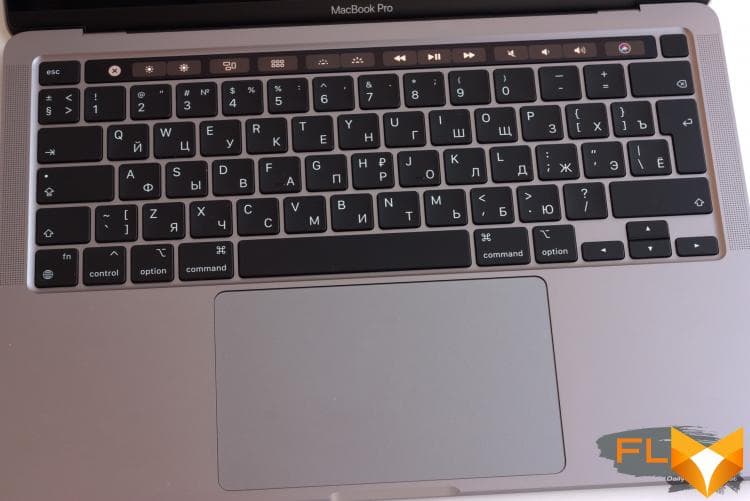
Instead of a row of function keys, the laptop has a responsive OLED Touch Bar. And even if you do not like this innovation, you will have to put up with it. Varieties of the MacBook Pro with function keys are no longer produced. The Touch Bar did not absorb only the Escape key and the power switch, combined with a biometric sensor. What the novelty does not yet have is a pair of additional Thunderbolt / USB Type-C connectors. Yes, yes, in any configuration of a laptop, regardless of the main components, there are now only two connectors for connecting peripherals (not counting the mini jack for analog audio), one of which will be occupied by the power cable.

The machine is charged with the same compact 61W voltage regulator as the previous Intel-based model.
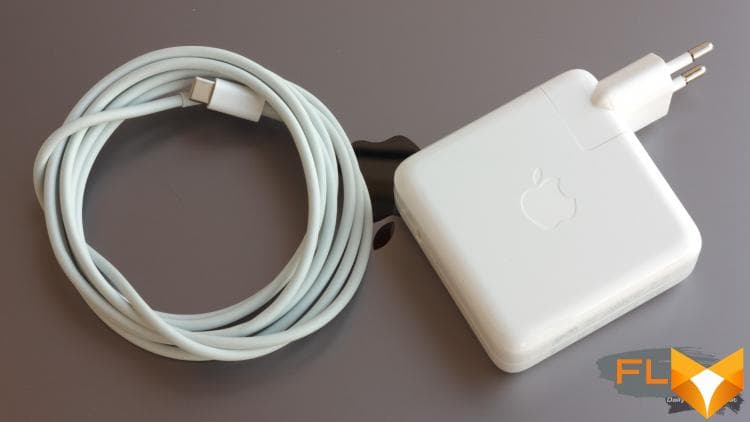
⇡#Internal design and upgrade options
When it comes to modern Apple laptops, the words “upgradeability” in the title are perhaps inappropriate. Not a single component of the system, including RAM and, most importantly, SSD, can be replaced by the user here – as, in fact, in the MacBook Pro of several previous generations.
Also, note that Apple hasn’t made significant changes to the SoC’s cooling system compared to Intel’s variant of the machine, which, to put it mildly, is not the benchmark for quietness during intensive work. All hope is that the noise problem has been solved by the energy efficiency of the processor (whether it is or not, you will find out on the next page of the review).
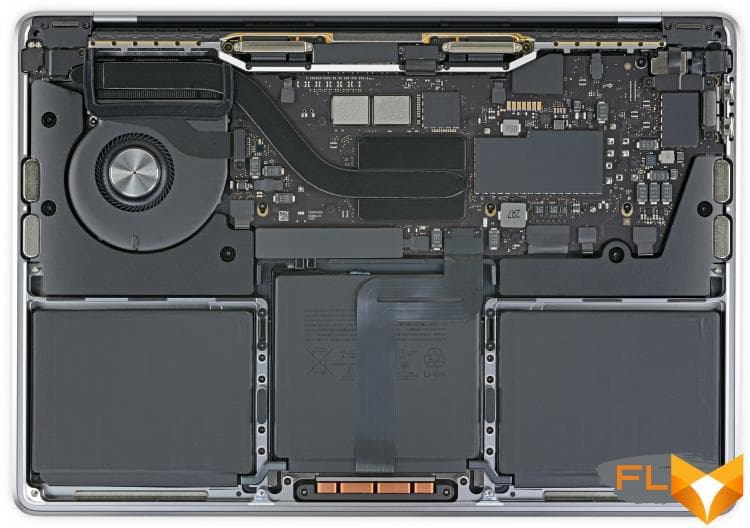
iFixit Photo
⇡#Test Methodology
| Synthetic tests | |
|---|---|
| Application | Settings |
| Geekbench 4/5 | — |
| CINEBENCH R20/R23 | — |
| GFXBench 5 (Aztec Ruins — Normal Tier, High Tier) | Windows: Vulkan, macOS: Metal |
| fio 3.16 | Sequential read/write, random read/write (unbuffered I/O) |
| Working Applications | |||||
|---|---|---|---|---|---|
| Application | Benchmark | Settings | API | ||
| Intel Graphics | AMD Graphics | NVIDIA Graphics | |||
| Adobe After Effects CC 2019 | PugetBench for Afer Effects 0.82 (linked test structure) | — | OpenCL (Windows)/Metal (macOS) | OpenCL (Windows)/Metal (macOS) | CUDA |
| Adobe Photoshop CC 2019 | PugetBench for Photoshop CC 0.8 (linked test structure) | Basic Benchmark | OpenGL + OpenCL + Metal (macOS) | OpenGL + OpenCL + Metal (macOS) | OpenGL + OpenCL |
| Adobe Premiere Pro CC 2019 | PugetBench for Premiere Pro 0.8 (linked test structure) | Standard Benchmark | OpenCL (Windows)/Metal (macOS) | OpenCL (Windows)/Metal (macOS) | CUDA |
| Blackmagic Design DaVinci Resolve Studio 16/17.1 Beta | Puget Systems DaVinci Resolve Studio Benchmark 0.61 (test structure by link) | 4K Benchmark | OpenCL (Windows)/Metal (macOS) | OpenCL (Windows)/Metal (macOS) | CUDA |
| Fusion | |||||
| Blender 2.81a | Class Room demo from Blender Foundation | Cycles renderer. Feature Set: Supported. Tile size: 32 × 32 (CPU) or 256 × 256 (GPU) | N/A (CPU rendering) | OpenCL (Windows)/CPU (macOS) | CUDA/OptX |
| AMD Nissan GTR Demo | Radeon ProRender | N/A | OpenCL (Windows)/Metal (macOS) | OpenCL | |
Display testing is performed using a Datacolor Spyder4 Elite colorimeter in ArgyllCMS and DisplayCAL 3 applications.
Notebook battery life is measured at a display brightness of 200 cd/m2 in the following usage scenarios:
- web surfing: alternately opening and closing tabs of 3DNews.ru, Computeruniverse.ru and Unsplash.com sites with an interval of 25 seconds in the Google Chrome browser (cache and cookies are disabled);
- Continuous playback of 4K HEVC (H.265) video.
⇡#Test participants
The following devices took part in testing:
| Screen | CPU | RAM | GPU | SSD | HDD | Battery | |||
|---|---|---|---|---|---|---|---|---|---|
| Apple MacBook Pro 13″, Late 2020 (A2338) | 13.3”, 2560 × 1600, IPS | Apple M1 | 4+4 cores/threads, ≤3.2GHz | LPDDR4X SDRAM, 4266 MT/s, 16 GB | 8 iGPU cores | System RAM | Apple AP2048Q (Apple Fabric) 2048 GB | None | 58.2 Wh |
| Apple MacBook Air , Early 2020 (A2179) | 13.3”, 2560 × 1600, IPS | Intel Core i5-1030NG7 | 4/8 cores/threads, 1.1-3.5GHz | LPDDR4X SDRAM, 3733 MT/s, 8 GB | Intel Iris Plus Graphics G7 | 1.5GB of system RAM | Apple AP0512N (PCIe 3.0 x4) 512 GB | None | 49.9 Wh |
| Apple MacBook Pro 16″, Late 2019 (A2141) | 16”, 3072 × 1920, IPS | Intel Core i9-9980HK | 8/16 cores/threads, 2.4-5.0GHz | DDR4 SDRAM, 2666 MT/s, 16 GB | AMD Radeon Pro 5500M | 4GB GDDR6 | Apple AP1024N (PCIe 3.0 x4) 1024 GB | None | 100 Wh |
| ASUS ZenBook 14 (UM433IQ) | 14”, 1920 × 1080, IPS | AMD Ryzen 7 4700U | 8/8 cores/threads, 2.0-4.1 GHz | LPDDR4X SDRAM, 4266 MT/s, 16 GB | NVIDIA GeForce MX350 | 2GB GDDR5 | Samsung PM981 (PCIe 3.0 x4) 1024 GB | None | 50 Wh |
| Dell XPS 13 9300 | 13.4″, 3840 × 2400, IPS | Intel Core i7-1065G7 | 4/8 cores/threads, 1.3-3.9GHz | LPDDR4X SDRAM, 3733 MT/s, 16 GB | Intel Iris Plus Graphics G7 | System RAM | KIOXIA XG6 (PCIe 3.0 x4) 512 GB | None | 52 Wh |
| HP ProBook x360 435 G7 (1L3L2EA) | 13.3″, 1920 × 1080, IPS | AMD Ryzen 7 4700U | 8/8 cores/threads, 2.0-4.1GHz | DDR4 SDRAM, 3200 MT/s, 16 GB | AMD Radeon RX Vega 7 | 512MB of system RAM | Samsung PM991 (PCIe 3.0 x4) 512 GB | None | 45 Wh |
| Lenovo Yoga Slim 7 (14ARE05) | 14”, 1920 × 1080, IPS | AMD Ryzen 7 4700U | 8/8 cores/threads, 2.0-4.1GHz | LPDDR4X SDRAM, 4266 MT/s, 16 GB | AMD Radeon RX Vega 7 | 512MB of system RAM | UMIS RPITJ256VME2MWD (PCIe 3.0 x4) 256 GB | None | 61 Wh |
| MSI Modern 15 (A11SB) | 15.6”, 1920 × 1080, IPS | Intel Core i7-1165G7 | 4/8 cores/threads, 2.8-4.7GHz | DDR4 SDRAM, 3200 MT/s, 16 GB | NVIDIA GeForce MX450 | 2GB GDDR5 | Kingston OM8PCP3512F-AI1 (PCIe 3.0 x2) 512GB | None | 52 Wh |
| MSI Prestige 14 (A10SC) | 14”, 1920 × 1080, IPS | Intel Core i7-10710U | 6/12 cores/threads, 1.1-4.7GHz | LPDDR3 SDRAM, 2133 MT/s, 16 GB | NVIDIA GeForce GTX 1650 Max-Q | 4GB GDDR6 | Samsung PM981 (PCIe 3.0 x4) 1024 GB | None | 52 Wh |
⇡#Screen Quality
We’ve become accustomed to Apple putting benchmark-quality screens in their devices, and the late 2020 MacBook Pro is no exception. It has the highest brightness (394 cd/m2) of any 13- and 14-inch laptops we’ve tested over the year, and its 1458:1 contrast ratio is second only to OLED panels and some particularly outstanding varieties of IPS.
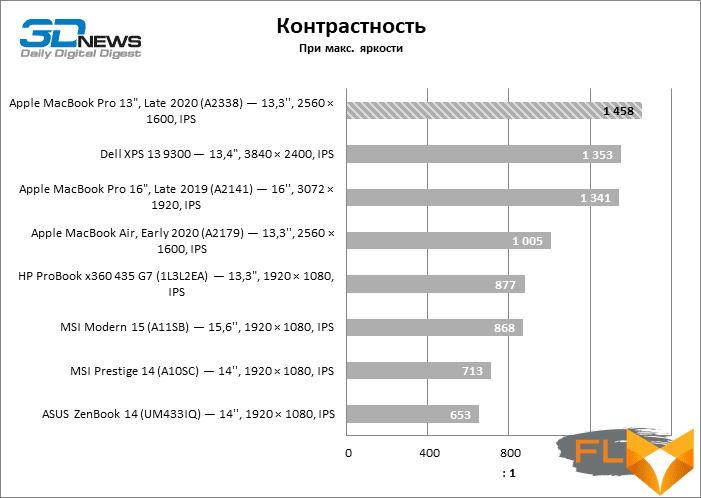
The display is calibrated to the DCI-P3 (or Display P3) color space and covers it entirely with high fidelity base colors. Because most macOS applications rely on the color grading system, when playing sRGB content, the color gamut is compressed to prevent oversaturation.
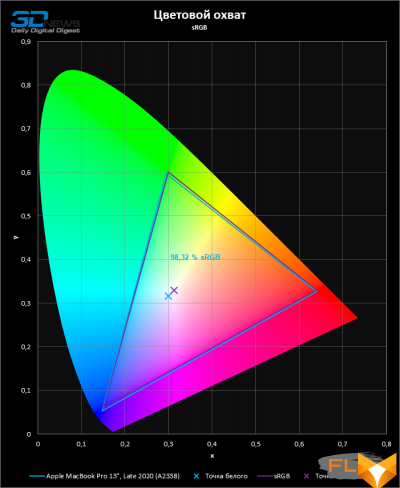 | 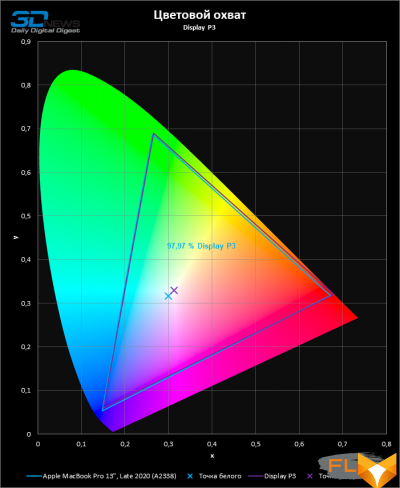 |
Gamma correction strictly obeys the 2.2 power function that distinguishes the Display P3 standard from DCI-P3. The base color curves are almost perfectly matched.
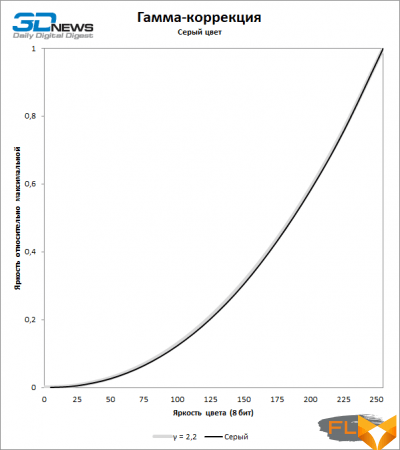 |  |
But the white point, which should have been in the D65 position according to the Display P3 specifications, is shifted towards cold shades. As a consequence, the color temperature of the gray scale is around 7200-7300K.
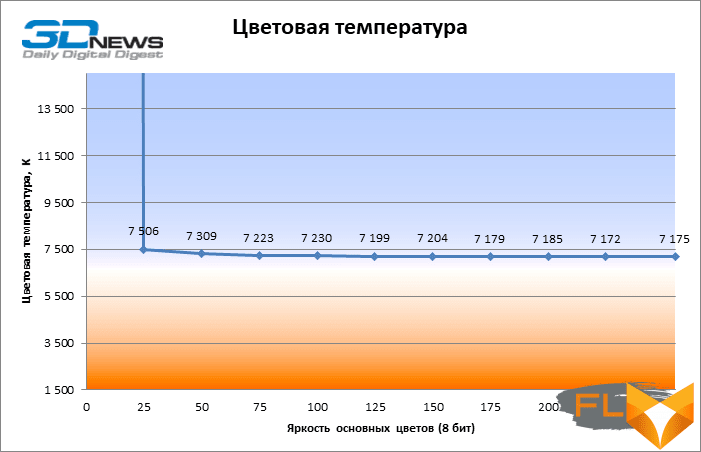
DisplayCAL, which we usually use to measure color deviation, cannot yet directly access the screen of an M1 laptop, so we had to measure through Safari and the application’s web server. The browser interprets DisplayCAL samples as sRGB, and the test results give no idea of color reproduction in the wide color gamut. But we can assure you that in sRGB mode, the factory calibration guarantees excellent Delta E (corrected for white point) estimates by consumer and prosumer standards.
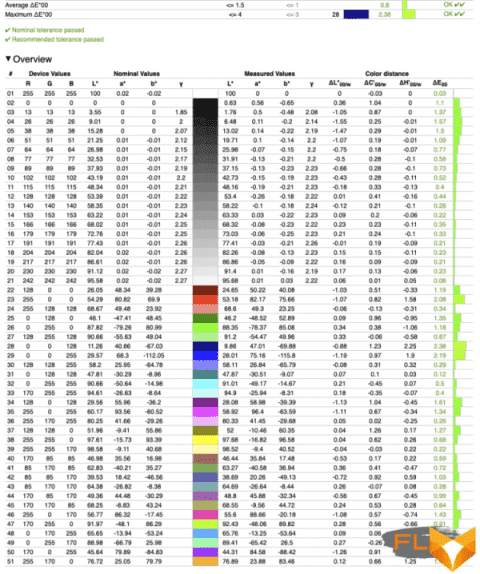
Finally, it is impossible not to pay attention to one more advantage of the MacBook Pro display. Apple uses arguably the best anti-glare coating we’ve ever seen on a laptop screen. Glossy glass reflects a minimum of external light and does not become a mirror even on a bright sunny day.
⇡#Clock speeds, temperature and noise level
The M1 chip is based on an architecture whose main advantage is pipeline width rather than high clock speeds. However, thanks to the advanced 5nm process technology, the cluster of high-performance M1 (Firestorm) cores, when fully loaded, clocks at a significantly higher level compared to all analogues that can be found in modern ultrabooks – six-core chips from the Comet Lake family, quad-core Ice Lake, and even the latest Tiger Lake – under comparable TDP conditions. Even the Ryzen 4000-series processors are no exception, but in their respect it is worth making an allowance for the fact that all eight Zen cores develop the same performance, unlike the asymmetric M1 architecture.
In Cinebench’s multi-threaded test, the powerful Firestorm cores hover around 3 GHz, while the power-efficient Icestorm cores are locked at 2 GHz. The Firestorm clock ceiling that can be observed in single-threaded operation lies around 3.2 GHz, which is in line with data from other independent researchers. Thus, M1 can maintain frequencies close to peak values, regardless of the nature of the load.
When the integrated GPU is resting, the power consumption of the entire system-on-a-chip does not exceed 18 watts. On the contrary, rendering by means of integrated graphics with a slight load on the CPU costs only 8-9 watts. The GPU itself runs at moderate clock speeds around 1.3 GHz. Judging by our measurements, the SoC of the new MacBook has a total power reserve of 20-21 W, so the simultaneous operation of the CPU and GPU does not cause significant drawdowns in the clock frequencies of either component: the Firestorm cores stabilize at 2.7 GHz, and the transition to a combined load did not affect the GPU frequencies at all.
Also worth noting is the extremely low idle power consumption of the M1 chip. When the computer is in active mode, but no resource-intensive processes are running in the operating system, the power of the SoC drops to 0.02-0.08 watts!
| Load Clock | ||||||||
|---|---|---|---|---|---|---|---|---|
| Cinebench R20 (Max Thread #) | LuxMark 3.1 | Cinebench R20 (Max Thread #) + LuxMark 3.1 | ||||||
| CPU clock speed, MHz | GPU clock speed, MHz | CPU clock speed, MHz | GPU clock speed, MHz | |||||
| Average | Max | Medium | Max | Medium | Max | Medium | Max | |
| Apple MacBook Pro 13″, Late 2020 (A2338) – Apple M1 / 8 iGPU cores | 2061 (E-cluster)/2987 (P-cluster) | 2064 (E-cluster)/3013 (P-cluster) | 1278 | 1278 | 2060 (E-cluster)/2704 (P-cluster) | 2064 (E-cluster)/3046 (P-cluster) | 1278 | 1278 |
| ASUS ZenBook 14 (UM433IQ) – AMD Ryzen 7 4700U / NVIDIA GeForce MX350 – Standard | 2694 | 3419 | 1321 | 1493 | 1409 | 1637 | 1301 | 1493 |
| MSI Modern 15 (A11SB) – Intel Core i7-1165G7 / NVIDIA GeForce MX450 – Silent | 2510 | 2640 | 1780 | 1785 | 972 | 996 | 1770 | 1770 |
| Dell XPS 13 9300 – Intel Core i7-1065G7 / Intel Iris Plus Graphics G7 – Ultra Performance | 1943 | 2794 | 842 | 898 | 1085 | 1397 | 616 | 798 |
| MSI Prestige 14 (A10SC) – Intel Core i7-10710U / NVIDIA GeForce GTX 1650 Max-Q – Balanced | 1817 | 1896 | 1192 | 1590 | 1730 | 1796 | 930 | 930 |
| CPU and GPU power | ||||||||
|---|---|---|---|---|---|---|---|---|
| Cinebench R20 (Max Thread #) | LuxMark 3.1 | Cinebench R20 (Max Thread #) + LuxMark 3.1 | ||||||
| CPU power consumption, W | GPU power consumption, W | CPU power consumption, W | GPU power consumption, W | |||||
| Medium | Max | Medium | Max | Medium | Max | Medium | Max | |
| Apple MacBook Pro 13″, Late 2020 (A2338) – Apple M1 / 8 iGPU cores | 17 | 18 | 8 (Entire SoC) | 9 (whole SoC) | 20 (whole SoC) | 21 (whole SoC) | N/A | N/A |
| ASUS ZenBook 14 (UM433IQ) – AMD Ryzen 7 4700U / NVIDIA GeForce MX350 – Standard | 19 | 30 | N/A | N/A | 10 | 10 | N/A | N/A |
| MSI Modern 15 (A11SB) – Intel Core i7-1165G7 / NVIDIA GeForce MX450 – Silent | 18 | 18 | N/A | N/A | 15 | 15 | N/A | N/A |
| Dell XPS 13 9300 — Intel Core i7-1065G7 / Intel Iris Plus Graphics G7 — Ultra Performance | 16 | 29 | 15 | 15 | 15 | 20 | 15 | 15 |
| MSI Prestige 14 (A10SC) — Intel Core i7-10710U / NVIDIA GeForce GTX 1650 Max-Q — Balanced | 15 | 15 | 31 | 31 | 15 | 15 | 16 | 16 |
Note The measurement is performed after the device has warmed up and all parameters have stabilized.
As a consequence of the SoC’s excellent power management under low load, the laptop’s cooling system spends most of its time in passive mode. Web surfing, watching movies – for such tasks, the computer does not need to turn on the fan at all. Therefore, it is not in the related version of the MacBook Air on the M1 chip. When the load is mainly on the integrated graphics, the fan starts up at low speeds and makes almost no noise. When the bulk of the task falls on the CPU cores, the machine is also extremely quiet. But with a combined load, the new MacBook Pro, alas, is as loud as a MacBook Air or a 16-inch Proshka on Intel chips.
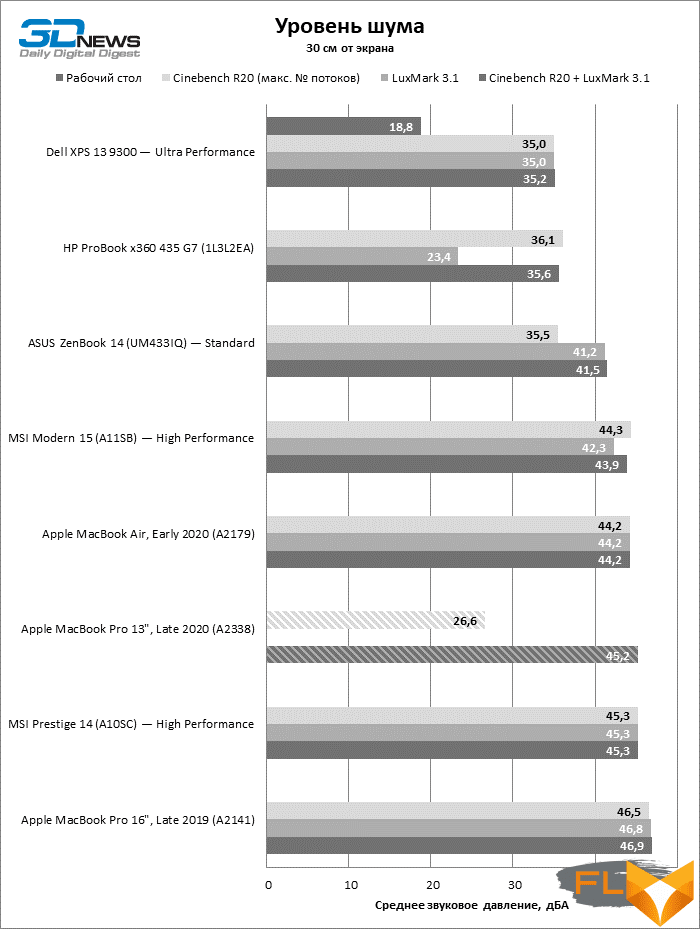
The cooler of the 13-inch MacBook Pro does not provide satisfactory results in cooling the components either. In demanding workloads, CPU core temperatures can reach up to 97°C. Fortunately, such conditions arise only under intense continuous load – such as ray tracing in 3D modeling programs or video encoding.

⇡#Synthetic performance tests
It is still very difficult to give an adequate assessment of the performance of the M1 chip, because most of the synthetic benchmarks and real applications that we use to test ultrabooks have not yet been transferred to the ARM architecture with all the optimizations for Apple silicon. The lion’s share of programs will initially be forced to work through the Rosetta 2 emulator, which provides excellent compatibility with the existing software library, but entails quite predictable performance overheads. Fortunately, we were able to put together a good set of benchmarks to compare the new MacBook Pro against modern systems based on Intel and AMD chips both in x86 code emulation and in native mode.
So, even with the encumbrance of an emulator, the M1 beat all rivals in single-threaded and multi-threaded CPU performance in the Geekbench synthetic test, with the exception of the 16-inch MacBook Pro with an eight-core Intel processor on board. In Cinebench R20, the Apple processor stopped at the level of Intel’s quad-core Ice Lake and six-core Comet Lake chips (and there is no question of competing with the Ryzen 4000 series). But such a result will appear in a completely different light, given that we benchmark Windows laptops in the maximum CPU power consumption mode, which is sometimes twice the power of the M1.
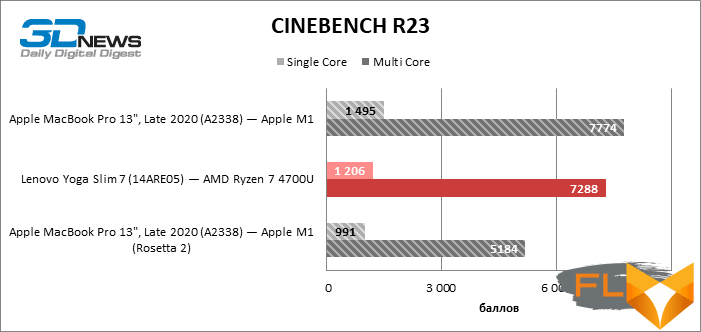
But the most interesting thing happens when the M1 runs ARM code compiled and optimized for the SoC architecture. Unfortunately, we no longer had access to all the systems whose results we brought in to compare with the performance of the new MacBook Pro, but we have a machine on the eight-core Ryzen 7 4700U chip at hand, the full review of which we will publish soon, and this, according to by and large, one of the best mobile CPUs in the world of Windows and x86 architecture. The latest versions of Geekbench tests and especially Cinebench illustrate well that the performance drop under the influence of the emulator is really great. But when apps are running natively on the M1, the Apple silicon confidently outperforms the Ryzen 7 4700U in single-threaded and multi-threaded performance, even though both processors are in the same power consumption class.
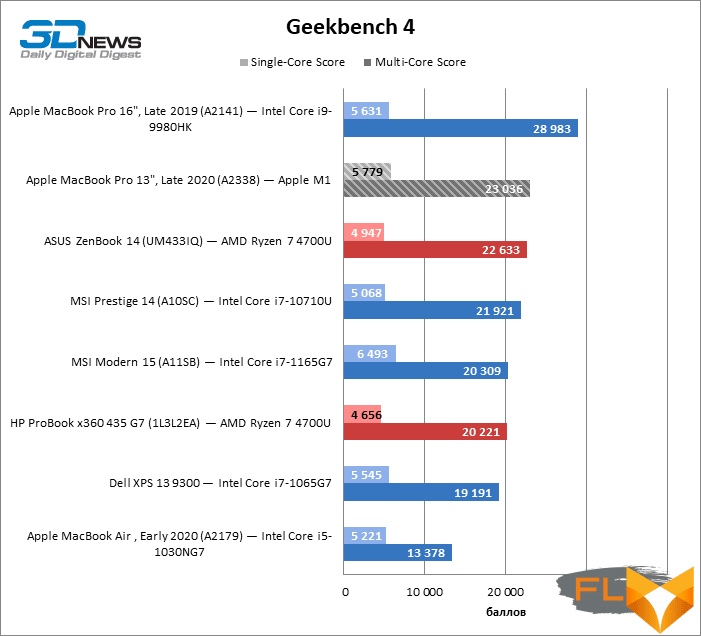
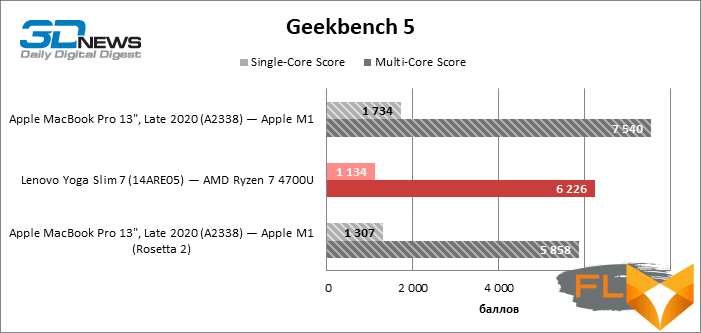
But emulation did not have a practically significant effect on the performance of the integrated GPU. M1 graphics competes on equal terms with entry-level discrete video adapters – NVIDIA GeForce MX350 and MX450 – and several times exceeds the frame rate of any integrated solution. Of course, the MacBook Pro is not a gaming system or a 3D rendering farm at all, but given that the 13-inch models of the past generation were content with integrated Intel graphics, the novelty is now much better suited to claims to be a mobile workstation. Fortunately, we have a whole battery of professional software to make sure of this.
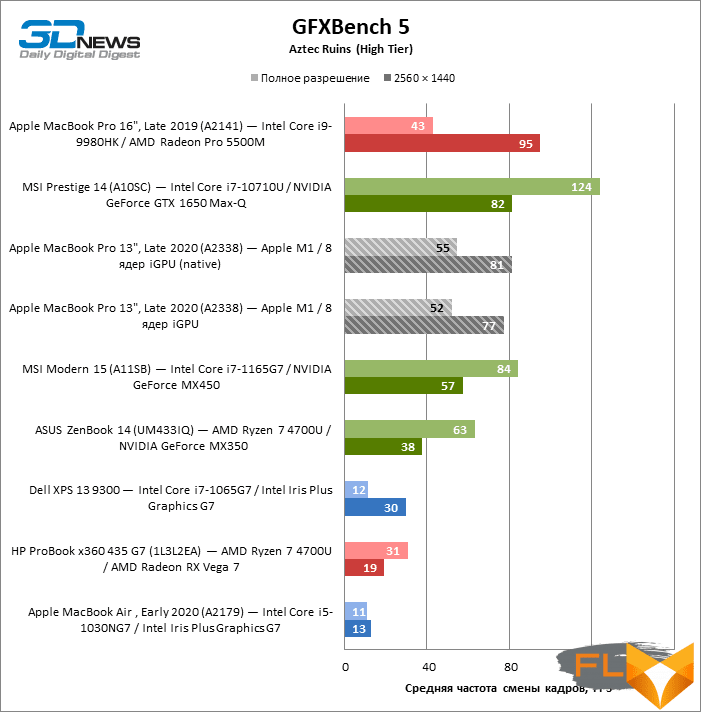
⇡#Performance in production applications
Unlike the synthetic benchmarks, we had to run most of our production applications on the new MacBook Pro in x86 emulation mode, which, as we found out, seriously burdens the M1 chip. Fortunately, in most cases, SoC overcomes the limitations that emulation imposes on the speed of programs. So, rendering in Blender using the Cycles engine, the machine already performed faster than all rivals, with the exception of a laptop on an eight-core Ryzen and a 16-inch MacBook Pro.
Unfortunately, it is still impossible to involve M1 graphics in this problem. At least in Cycles. In the ProRender benchmark, the integrated GPU outperformed all entry-level discrete solutions, including the new Turing-based GeForce MX450, and came pretty close to the power-efficient version of the GeForce GTX 1650 in the Max-Q thermal package.
By the way, we note that we collected the results of Apple laptops on the Intel platform while still running macOS 10.15 (Catalina), while the next generation model already has macOS 11 (Big Sur) installed – this may have some effect on performance, but, from what we know, it is not high in third-party applications.
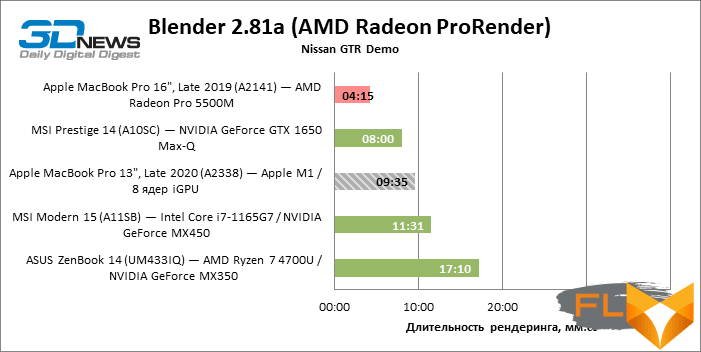
We are forced to skip the MacBook Pro test in Lightroom due to the fact that the PugetBench test suite only works on Windows. And it can no longer be installed on Apple’s bare metal, so for now, only an ARM build of Microsoft’s operating system can run on the M1. So let’s move on to the tests in the “big” version of Photoshop. Here, according to the final score of the complex benchmark, the equivalent of a MacBook Pro is a system with a six-core Intel processor, discrete GeForce GTX 1650 Max-Q graphics and corresponding power consumption. The 16-inch MacBook Pro and Intel’s latest Tiger Lake quad-core laptop are already out of reach for the MacBook Pro.
However, we do not exclude that, if not for emulation, the layout of the results could be completely different. Future versions of Photoshop 2021 will have native support for M1, and a public beta test is already underway. Alas, the beta version is still devoid of many functions, and, in particular, the PugetBench test package does not run on it, which means that there will be no benchmark results yet either.
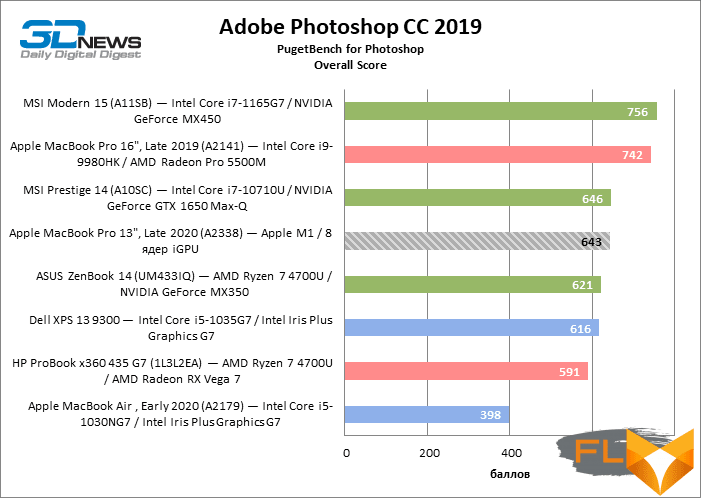
Note Scores are calculated as a percentage of Intel Reference Workstation performance Core i9-9900K, NVIDIA GeForce RTX 2080 and 64GB RAM x 10.

Note Scores are calculated as a percentage of Intel Reference Workstation performance Core i9-9900K, NVIDIA GeForce RTX 2080, 64GB RAM.
Not all ultrabooks are fast enough to pass the entire set of tests in the Premier Pro video editor and get the final score. The 13-inch MacBook Pro had no problem with this. Moreover, in terms of overall playback speed during installation, the laptop on the M1 is practically not inferior to the 16-inch MacBook Pro with an eight-core Intel CPU. In the task of exporting projects, the result is quite different. However, it is enough that here the novelty is not inferior to computers with discrete graphics GeForce MX450 and GTX 1650 Max-Q.
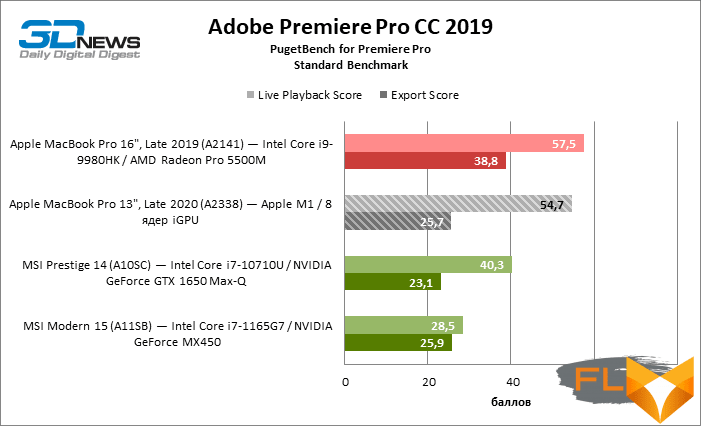
Note Scores are calculated as a percentage of the frame rate of the source or target format (for example, playing a video at full frame rate is worth 100 points). Unlike playback, when rendering video, the frame rate can exceed the target, which means that the score will be higher than 100.
In the video editing task, the M1 chip performs best when the load falls mainly on the CPU cores, and not on the integrated graphics. The frame rate of the video in the viewport was not much lower than on the 16-inch MacBook Pro, not to mention all the other test participants. Premiere Pro users will still need to use a proxy when working with 4K files, but ½ of the original resolution is enough to get the frame rate closer to 24 FPS. The new MacBook Pro’s CPU project export is as fast as the Ryzen 7 4700U despite emulation.
But if you overload the editing with effects that depend on the GPU, you can’t do without powerful discrete graphics. Here, the eight-core graphics processor in the M1 is inferior to solutions of the GeForce GTX 1650 Max-Q class, and sometimes entry-level chips like the GeForce MX450.
Until Adobe adapts its applications to the ARM architecture, owners of new Apple machines are better off using the native Final Cut Pro X video editor, which already fully unlocks the potential of the M1 chip. The only pity is that the tests that we could conduct in Final Cut Pro X would simply have nothing to compare with, since there are no modern “Macs” on Intel CPUs left in the editorial office.
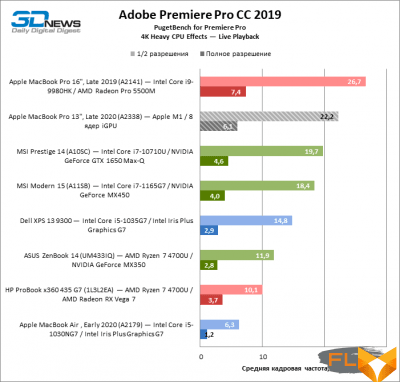 | 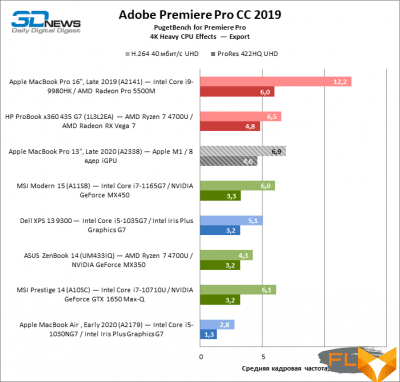 | |
 | 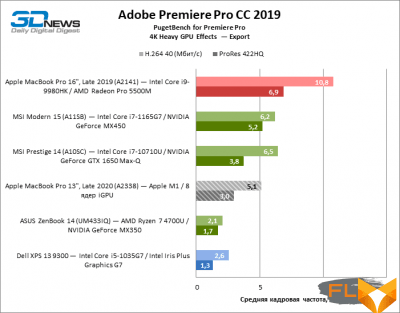 |
Among the ultrabooks that have passed through the 3DNews lab in the past year, the only two compact machines that have passed the DaVinci Resolve test sequence are the 16-inch MacBook Pro, and the MSI laptop with an Intel hexa-core processor and GeForce GTX 1650 Max-Q graphics. On the results chart, the next-generation 13-inch MacBook Pro came in between. As for the Fusion effects, here the M1 silicon showed just a giant advantage over its rivals in a test that contains object tracking and a chroma key cut.
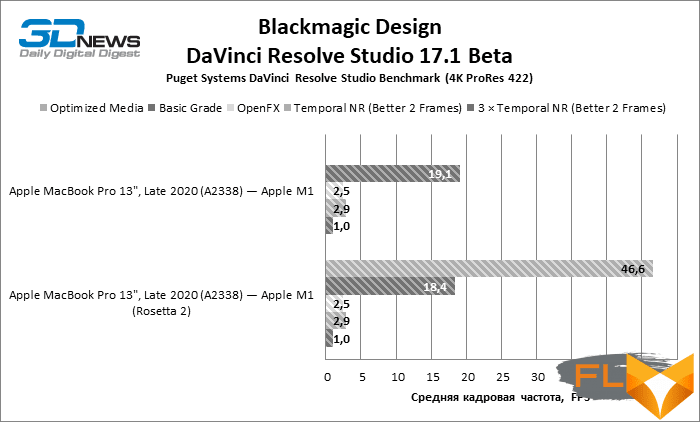
In addition to DaVinci Resolve 16, which runs on the M1 in x86 emulation mode, we ran the same tests with native-compiled beta 17.1. Judging by the main block of tasks, either the emulation does not cause a significant performance loss in DaVinci Resolve, or the beta is not yet fully optimized for the Apple architecture. In addition, the Optimized Media function, which is an analogue of proxy in this video editor, does not yet work in native mode. On the contrary, the Fusion effects, which the M1 already handles perfectly, received an impressive increase in speed.
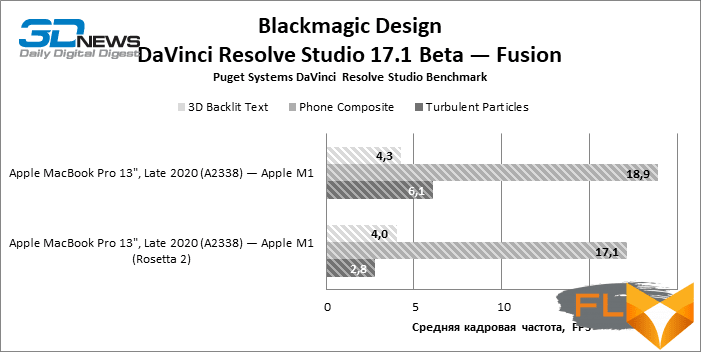
⇡#SSD Performance
Unlike Intel-based Macs, the new MacBook Pro’s SSD is bound to the SoC by Apple’s proprietary fabric bus rather than PCI Express, though it also runs on NVMe. This drive outperforms most if not all OEM models found in Windows laptops. In addition, the APFS file system (or the entire macOS software stack) allows you to handle ROM more efficiently. However, compared to the “old” SSD from Apple, the new one added only in the speed of sequential data writing, and in sequential and random reading, the ratio is reversed. In addition, the SSD of previous MacBooks has such a feature that the throughput gradually decreases after the start of the load, even before the SLC cache reserve is exhausted. The decline section is cut off in the test logs, and this is also worth taking into account when comparing drives in Intel’s MacBook Pros and new products on the M1.
In addition, there are a number of nuances that may be associated with the organization in the macOS environment of asynchronous I / O through the POSIX AIO interface, which provides direct unbuffered access to storage and, in general, extremely high throughput. So, the MacBook Pro drive was notable for its unsatisfactory linear write speed with a single command queue (as, indeed, the SSD in the previous generation models) and, in general, slow random write. However, it is possible that in the case of machines based on the M1 chip, part of the blame lies with the test tool: the fio program also works through the Rosetta 2 emulator.
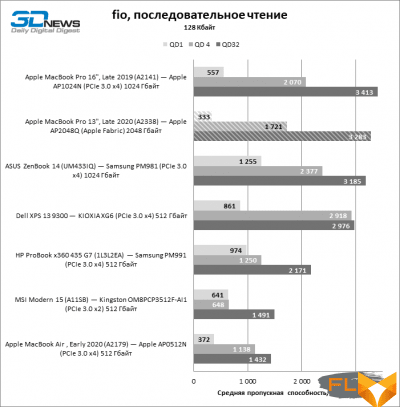 | 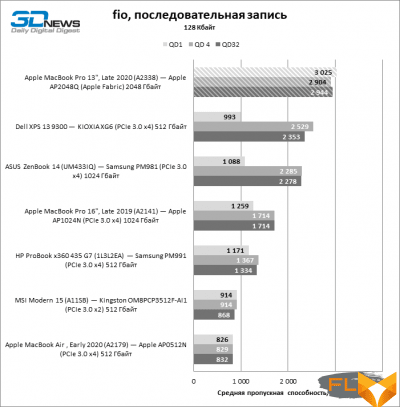 | |
 | 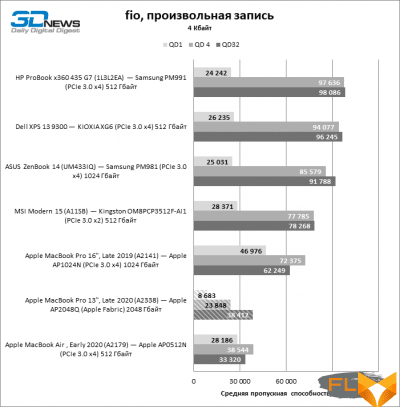 |
Be that as it may, the speed of the ROM has made a major leap, if we take as a starting point not the 16-inch MacBook Pro, but, for example, the early 2020 MacBook Air. And the point here is not in the SSD itself, but in the fact that the M1 CPU is much better at processing a huge number of requests than the low-wattage Intel counterpart. To remove the limit on the number of threads and processes that can run concurrently through POSIXAIO, we use the following command:
sudo sysctl -w kern.aiomax=2048 kern.aioprocmax=1024 kern.aiothreads=16
As a result, the quad-core Ice Lake chip reaches full load and becomes the bottleneck of the entire system, and this is no longer the case with the M1.
⇡#Battery life
The strength of the new MacBook Pro is not only the best performance in its class, but also record-breaking battery life. Firstly, it simply has the most capacious battery of any laptop with a diagonal of 13-14 inches, which we attracted for comparison. And secondly, the M1 chip has excellent power efficiency, and at low load, the power consumption of the SoC drops to 20-80 mW.
As a result, while some machines with Intel CPUs have to dim the screen to 165 or even 100 cd/m2 to last longer on a single charge, an Apple laptop can play HEVC video for 13 hours. in a row with a screen brightness of 200 cd/m2. It was not possible to repeat exactly the same result with continuous web surfing – probably to some extent due to x86 architecture emulation. The fact is that the Google Chrome browser that we use in the autonomy test is already compiled in a universal binary format, but the chromedriver program that scrolls through the pages is not. As a result, Chrome itself runs under the emulator, which causes additional energy consumption. In addition, Apple says that the new version of Safari in macOS Big Sur is specifically optimized to save battery. Nevertheless, even now, the MacBook Pro on the M1 platform ran a web marathon lasting 10 hours and 45 minutes.
Note At first, something went wrong in the web surfing test, and we got a significantly lower battery life. The review has now been supplemented with corrected results.
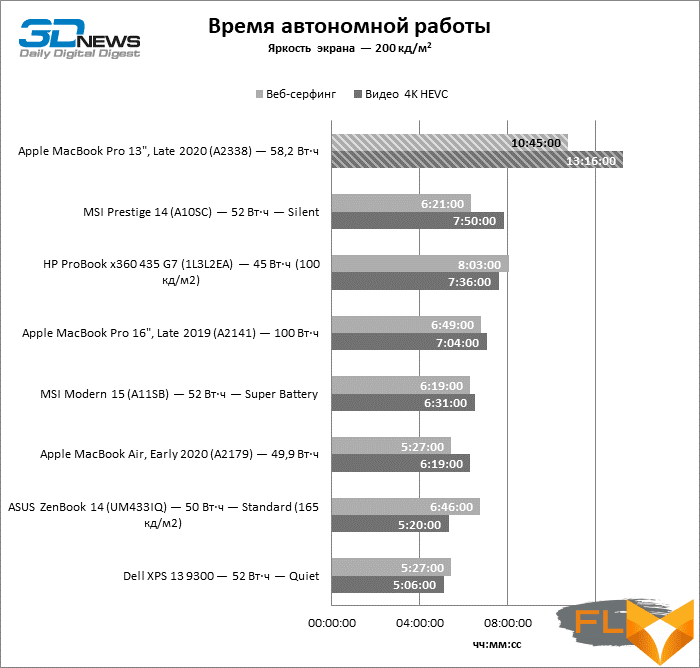
⇡#Conclusions
The system-on-a-chip, based on the ARM architecture with a lot of proprietary blocks and optimizations that Apple engineers have brought, stands head and shoulders above all analogues from the x86 world in terms of performance per watt. Even Ryzen 4000-series mobile processors do not make such a strong impression against the backdrop of the M1 system-on-a-chip. However, the advantage in energy efficiency, characteristic of Apple silicon, was perfectly illustrated by the A-series processors in the iPhone and iPad, and for a long time. More importantly, the M1 easily outperforms all competitors in its class, including eight-core Ryzens, in absolute performance metrics in both single-threaded and multi-threaded tasks. Provided that the application code is compiled for the ARM instruction set and contains all the necessary optimizations. Otherwise, when macOS has to run code through the Rosetta 2 emulator, Ryzen 4000 and, in exceptional cases, Intel’s latest Tiger Lake chips have a chance to win. But only at the cost of power consumption, which is 1.5-2 times the energy budget of the M1 in the 13-inch MacBook Pro chassis. There can be no doubt about Apple’s technological leadership here, and as more applications move to the ARM architecture, it will only increase. Will it still happen when Apple scales the M1 logic to 16 processor cores and more, and this will also happen sooner or later.
In addition to the champion CPU, the new MacBook Pro boasts a fully unlocked integrated graphics configuration with eight processing cores. Thanks to the M1, the machine no longer needs a discrete GPU, because the integrated solution is not inferior in performance to entry-level discrete chips like the GeForce MX450, and in some tasks it approaches the GeForce GTX 1650 Max-Q. For the 13-inch MacBook Pro, this is especially important, because Apple has long deprived them of discrete graphics. Throw in an extremely fast SSD and you have one of the best performing 13- to 14-inch ultrabook machines out there, but unlike its x86-based competitors, Apple doesn’t have to sacrifice battery life for performance. The new MacBook Pro lives phenomenally long unplugged.
Perhaps the only complaint that can be made to the main components of the novelty concerns the amount of RAM, limited to 16 GB. It’s better not to think about configurations with 8 GB of RAM at all if you are going to run more or less demanding applications on a laptop, but 16 GB is still not enough to call the MacBook Pro a full-fledged workstation, albeit a mobile one.
But Apple still does not save on the quality of screen matrices. We constantly criticize the screens of ultrabooks, which sometimes cost no less money than the MacBook Pro, but we have no serious complaints about this matrix. It has a huge margin of brightness and contrast, a P3 color gamut, and thanks to end-to-end color correction in macOS and pre-calibration, the computer can be immediately used for professional rendering. All that is needed is for the hardware profiling software to learn how to work with the M1 platform without existing restrictions in order to compensate for the overestimated color temperature.
The chassis of the 13-inch MacBook Pro has undergone minimal changes compared to the previous generation, which is both good and bad. The MacBook Pro is one of the thinnest machines in its class, and the mechanics of the keyboard and touchpad are beyond praise. However, the wide frames around the screen start to look outdated, and most importantly, along with the transition to proprietary silicon, the shortage of cable interfaces has only worsened. Apple doesn’t have laptop configurations on the M1 with four Thunderbolt/USB ports, and the chip doesn’t allow more than one external display. If you recall the limitation on the amount of RAM, the word Pro in the name of the device is no longer quite appropriate. Another problematic point: both RAM and SSD are all soldered on the laptop motherboard and cannot be upgraded. It is better to choose a MacBook Pro configuration with a reserve for the future, and then do not neglect regular data backups. Finally, Apple should have strengthened the cooling system. In most tasks, the machine is extremely quiet or completely cooled in passive mode, but when the CPU and GPU are fully loaded at the same time, it still makes noise, and loudly.
However, despite the limitations of the first Apple desktop silicon and some shortcomings of the MacBook Pro chassis, we have before us a quite serious prosumer machine adjusted for the form factor, and for undemanding activities and work on the road, its capabilities are enough for the eyes. If you do not take into account the operating system macOS, which does not suit everyone, “Macbooks” are bought for the win-win combination of screen, controls, long battery life and, to be honest, “apple” aesthetics. In this, the late 2020 13-inch MacBook Pro still excels, but is now much faster and lasts longer on a single charge. Finally, Apple’s success with ARM’s M1 chip is an important signal for the entire IT industry, which we are sure will not go unnoticed.
FAQ Apple macbook pro 13 late 2020 (a2338)
What color options are available for the MacBook Pro 13-inch?
The MacBook Pro 13-inch is available in several color options, including the popular Space Gray.
How does Touch ID enhance the security of the MacBook Pro?
Touch ID on the MacBook Pro provides a secure and convenient way to unlock the device, authorize purchases, and authenticate user identity.
What are the capabilities of the 8-core Apple M1 chip in the MacBook Pro?
The 8-core Apple M1 chip in the MacBook Pro offers powerful performance, with an 8-core CPU for fast processing and an 8-core GPU for advanced graphics tasks.
How many Thunderbolt ports does the MacBook Pro M1 feature?
The MacBook Pro M1 features two Thunderbolt ports, allowing for high-speed data transfer and connection to a range of peripherals.
What are the storage options available in the 2020 M1 MacBook Pro?
The 2020 M1 MacBook Pro comes with various SSD storage options, including 256GB and 512GB SSDs.
Does the MacBook Pro support Apple TV and iOS apps?
Yes, the MacBook Pro supports Apple TV and can run iOS apps, thanks to the versatility of the Apple M1 chip and macOS.
How does the Retina display enhance the visual experience on the MacBook Pro?
The Retina display on the MacBook Pro offers a high resolution of 2560 x 1600, delivering crisp and vibrant visuals with True Tone technology for a more natural viewing experience.
What are the differences between the new M1 chip and the new M2 chip in MacBook Pros?
The new M1 chip focuses on efficient performance with an 8-core CPU and GPU, while the new M2 chip, introduced in 2022, brings advancements in processing power and energy efficiency.
How long can the MacBook Pro last on a single charge?
The MacBook Pro with the M1 chip boasts an impressive battery life of up to 20 hours on a single charge, making it ideal for extended use without needing to recharge.
What are the RAM options available in the MacBook Pro 13-inch?
The MacBook Pro 13-inch offers RAM options of 8GB and 16GB, catering to different user needs for multitasking and performance.
What type of USB ports are available on the Apple MacBook Pro 13-inch?
The Apple MacBook Pro 13-inch is equipped with two Thunderbolt 3 ports, which support USB-C connectivity, offering high-speed data transfer and charging capabilities.
What are the SSD storage options for the MacBook Pro laptop?
The MacBook Pro laptop offers SSD storage options of 256GB and 512GB, providing fast access to files and efficient storage management.
How does the Force Touch trackpad enhance user interaction on the MacBook Pro?
The Force Touch trackpad on the MacBook Pro offers a responsive, pressure-sensitive surface that allows for a range of gestures and clicks, enhancing the overall user experience.
Is a headphone jack available on the Apple MacBook Pro 13-inch?
Yes, the Apple MacBook Pro 13-inch includes a headphone jack, allowing users to connect audio devices like headphones and speakers.
What are the camera specifications of the MacBook Pro for video calls?
The MacBook Pro features a FaceTime HD camera, providing clear and high-quality video for calls and conferencing.
What is the RAM capacity of the entry-level MacBook Pro?
The entry-level MacBook Pro typically comes with 8GB of RAM, providing sufficient memory for everyday tasks and some multitasking.
How does the 3.2 GHz Apple M1 processor impact the MacBook Pro’s performance?
The 3.2 GHz Apple M1 processor, with its 8-core CPU and 8-core GPU, significantly enhances the MacBook Pro’s performance, offering fast processing speeds and efficient handling of graphics-intensive tasks.
Can you describe the technical specifications of the Apple’s new M1 MacBook Pro 13-inch?
The new M1 MacBook Pro 13-inch features an Apple M1 processor, 8GB or 16GB of RAM, a 256GB or 512GB SSD, a 13-inch Retina display, and two Thunderbolt 3 ports, delivering powerful performance and high-speed connectivity.
Is the design of the MacBook Pro with Apple’s M1 chip identical to the previous model?
Yes, the design of the MacBook Pro with Apple’s M1 chip is largely identical to the previous model, maintaining a consistent look and feel while upgrading internal components.
How do users benefit from the M1 SOC in the MacBook Pro laptop?
The M1 SOC (System on Chip) in the MacBook Pro laptop offers integrated and efficient performance, with the processor, graphics, and memory all on a single chip, leading to enhanced speed and power efficiency.
